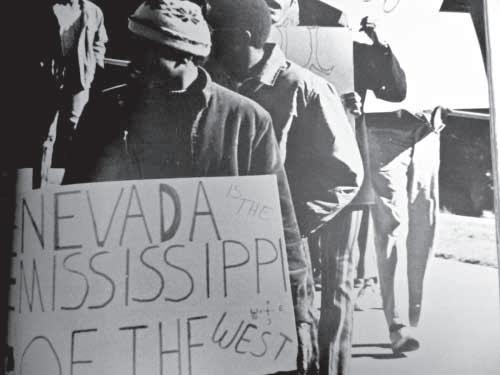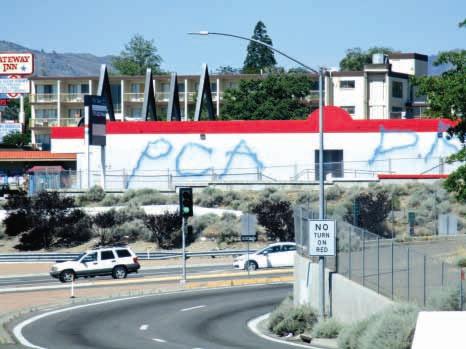
8 minute read
News
from July 2, 2015
Businesses: Cut state wages
Dotty’s neighborhood casinos and other businesses have gone to court to have Nevada’s minimum wage law declared unconstitutional, which would have the effect of lowering the Nevada minimum wage by a dollar.
Advertisement
Other Nevada businesses that are parties to the lawsuit are Landry’s Inc., Bubba Gump Shrimp Co., Laughlin River Lodge and Hoover Dam Lodge.
They seek to overturn on federal constitutional grounds the language in the state constitution that requires Nevada wages be a dollar above the national minimum wage set by Congress. Because Congress has been reluctant to keep the minimum at the level of inflation, in real dollar terms the congressional minimum has been losing value for 47 years.
The relatively new state law, placed on the ballot by initiative petition, called Question 6, was approved by Nevadans in 2006, 68.71 to 31.29 percent. Among the claims made by the litigant:
• “Question 6, however, went far beyond simply raising the minimum wage and altering the manner in which the minimum wage would be calculated. Indeed, the proposed amendment’s terms introduced a ‘health benefits’ component that would dictate the type of health plan an employer would be required to offer to its employees.”
This appears to refer to a provision in the new law that allows businesses to avoid paying higher minimums if they provide health insurance to their workers. It does not “dictate” that they provide health insurance.
• “Moreover, the Amendment does not authorize the Labor
Commissioner to regulate or enforce its provisions. Rather, it merely states, “The Governor or the State agency designated by the Governor shall publish a bulletin by April 1 of each year announcing the adjusted rates.”
Even if this is true, the Nevada Legislature has enacted statutes empowering the labor commissioner to enforce the minimum wage, such as Nevada Revised Statutes 608.180 and 608.250.
An effort to stop state government from enforcing the Nevada minimum competes with lawsuits already in court charging that the state fails to do so (“Minimum enforcement,” RN&R, May 29, 2014) and seeking court orders to require such enforcement.
Bradley Schrager, one of the attorneys who filed those lawsuits, responded to the new suit:
“The Nevada Constitution allows employers the privilege of paying down to $7.25 an hour, from $8.25, if their employees are provided health insurance. But the plaintiffs in this suit are contending they are forcibly regulated with confusing and burdensome rules. That’s just not true. No one forces Landry’s or Dotty’s to do anything in this regard. They submit themselves, voluntarily, to these rules because they want to find ways to pay their employee the absolute bare minimum. They could always choose to pay the full Nevada minimum wage off $8.25 per hour, and never worry about regulations or compliance at all. From what we can tell from ongoing lawsuits, however, what employers like Landry’s and Dotty’s really want is to not have to be responsible for either the full wage or health insurance, and that is what this suit is really about.”
Schrager and attorney Don Springmeyer filed their 2014 suits that name several companies they said were not complying with the law or were claiming the health insurance exemption without providing the insurance. They further charged that the Sandoval administration was failing to enforce the law.
The issue of wages became more sensitive after this year’s Legislature, where Republicans succeeded in ending the payment of the prevailing wage in the area of a taxpayer-funded school construction project. The measure was later amended, but still puts school construction wages lower than other public works.
Democrats have tried to make an issue of wages, but haven’t gotten much traction. In March, state Democratic publicist Zach Taylor attacked state GOP legislators for protecting corporations that “have been cheating Nevada workers out of the full minimum wage without offering any semblance of adequate health insurance.”
Symbols
Nevada and race have quite a history
The student newspaper at the University of Nevada, Las Vegas, the Rebel Yell, by once carried a Confederate flag on its Dennis Myers front page. Reno’s Club Cal Neva once had “Wild Indian Slots” and still had the term painted on its outer Virginia Street wall as late as the 1990s, though the slots themselves had already been discontinued. The logo still survives on a Mill Street warehouse. The old Reno plumbing supply house Savage and Son abandoned its onetime logo of a black native with a spear standing alongside his child. The dispute over the Confederate
James Richardson Author
flag that followed the Charleston church murders has prompted many to look deeper into symbols than they did before and even to face down those who claim that such introspection represents “political correctness.”
“Those who want to defend keeping the flag up, it’s one of their top defense mechanisms,” said University of Nevada, Reno social psychologist James Richardson. “And I certainly think political correctness can go too far.”
But Richardson also said symbols are important, that they are part of the way we define ourselves, so they matter. And the fact that Wild Indian Slots and the Savage and Son image were in use relatively recently shows that some sentiments may not be deeply buried.
Last week, the two party leaders in the Senate—majority floor leader Mitch McConnell of Kentucky and minority leader Harry Reid of Nevada—called for their home states to come to grips with identifying with the Confederacy. McConnell raised “the appropriateness of continuing to have Jefferson Davis’ statue in a very prominent place in our state capital.”
Reid called on Nevada to deal with the University of Nevada, Las Vegas’s long identification with the Confederacy.
“It’s up to the Board of Regents, and I believe they should take a look at it,” he said.
In an editorial attacking Reid, the Las Vegas Review-Journal said, “The university adopted Confederate symbols, not out of allegiance to racism and slavery, but to acknowledge the state’s fierce North-South rivalry and Nevada Southern University’s breakaway from the University of Nevada, Reno.” This claim has been made several times, but no one has cited evidence for it, and some have claimed it is a latter-day explanation.
During an October 1971 occupation of the UNR student union by African-American students, a protestor used one of Nevada’s nicknames on his sign.
One campus source said, “If they drop that concept, it’s going to cost them a fortune and another fortune to rebrand.”
The campus has made halfhearted gestures to break the Confederate linkage, but then would often embrace it again. The newspaper dropped the Confederate flag from its front page early on and changed its name from the Rebel Yell to the Yell in 1970. In 1983, it reestablished the identification with the name Yellin’ Rebel. And in 1992, it went right back to the Rebel Yell. (The term “rebel yell” refers to a battle cry by Confederate troops, several recordings of which by veterans have survived in the Library of Congress.) The original campus mascot was replaced by another campus mascot—but both had Confederate linkage. It all represents an odd stance in a state that brags about its association with President Lincoln.
When the Las Vegas campus was still technically an arm of the Reno campus called Nevada Southern University, the mascot was a wolf (ripped off directly from Disney’s Big Bad Wolf) wearing a Civil War soldier’s tunic and muster cap. It was replaced with a southern gentleman mascot, known as Reb or Hey Reb.
While UNLV made some concessions to public sensibilities here and there, it never entirely gave up its identification with the Confederacy, which made it vulnerable in occasional disputes.
For example, two years ago before a UNLV/University of New Mexico game, a UNLV fan created an online image of a black UNM basketball guard, Jamal Fenton, being walked on a leash by the current UNLV mascot. In the Albuquerque Journal, sportswriter Geoff Grammar reported, “Some critics of the image pointed out the image took on another level of racial connotation because the UNLV mascot, Hey Reb!, has Confederate Army origins. ... UNLV’s original mascot was, like UNM’s Lobo Louie, a wolf. The school originally used a black and white wolf named Beauregard who wore a Confederate hat to represent its athletics department.”
Richardson said of the UNLV/ Confederate association, “It kind of plays into the idea that Nevada’s the Mississippi of the West.”
It’s likely Nevada’s founders— who provided in the state constitution for establishment of a state university—would have been startled and very angered by UNLV’s embrace of Confederate symbolism.
“[E]very man must know and admit, that he who refuses to subscribe to the doctrine that every citizen owes allegiance to the federal government in the exercise of its functions, as prescribed and defined by the Supreme Court of the United States, thereby stamps himself plainly and ineffaceably with the brand of—call it what you will— Copperheadism, State Rights-ism, or any other ism that can be found in the ranks of that party and among those men who have plunged this country into the war that is now desolating its fair fields and its once happy homes,” said Nevada constitutional convention delegate Thomas Hawley in 1864.
But the founders never saw the impact of pop culture or the age of irony. When Alcatraz Island, once a federal prison, was occupied in 1969 by Native Americans—including at least one Nevada tribal member— under treaty language granting title to tribes of abandoned federal land, Life magazine called the United States “a nation curiously able to mythologize anything.”
There was a time when few people would have wanted to identify themselves with the Confederacy. But these days, a lot of
peculiar things are glorified—war, gangsters, Wall Street junk bond criminals. Richardson says this kind of idealizing unpleasant history “gives us continuity with our history.” Reid’s concern with historic symbolism did not start with the post-Charleston Confederate issue. Three years ago he called for removing the name of his predecessor, Patrick McCarran, from the airport ORIGINAL UNLV MASCOT in Clark County. McCarran’s name is also on the Truckee Meadows ring road, and a statue of McCarran is one of two Nevada sculptures in Statuary Hall in the U.S. capitol. McCarran was the author of legislation providing for race-based immigration policies and also of a measure that provided for U.S. concentration camps for citizens with unpopular opinions. “Pat McCarran was one of the most anti-Semitic—some of you might know my wife’s Jewish—one of the most anti-black, one of the most prejudiced people who has ever served in the Senate,” Reid said in 2012. Ω
CURRENT UNLV MASCOT
Vandals












